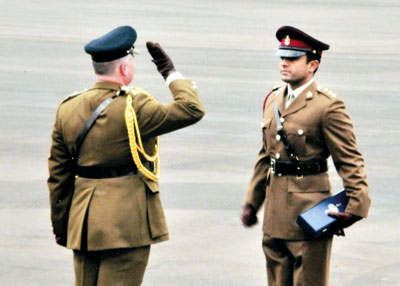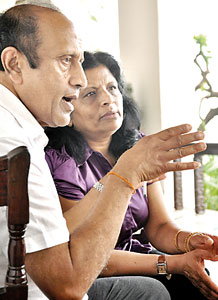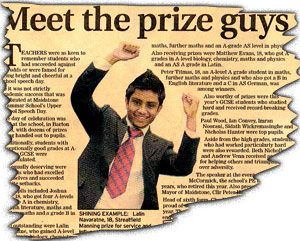We too salute you
View(s):What does it take to achieve great heights at Sandhurst, one of the most renowned military academies in the world? In this e-mail interview Kumudini Hettiarachchi finds out just that from young Captain Lalin B.M. Navaratne who has been presented the prestigious
‘Sword of Honour’
Brutal is the training beginning at the crack of dawn, 0430 to be precise, each day with the famous “water parade”. Standing on the line outside their rooms, under the watchful eye of the Colour Sergeant, a litre of water has to be downed, hard even though allowed to take time, before a packed day of training.

Sandhurst’s best: Lalin at the ceremony where he received the Sword of Honour
Each day, going into the first five long weeks, is strenuously full with military activity — infantry skills, fieldcraft, weapons handling, shooting with live ammunition, map reading/navigation exercises, physical training (PT), assault courses, drill, lessons in chemical, biological, radiological and nuclear warfare and that’s just to name a few.
Along with the military activity is the academic activity which includes learning about military tactics, history and discipline, war studies, becoming familiarised with the structure of the army and also essay writing. Some lessons are in the classroom, others on the assault course, training area or gym, requiring about seven to eight changes of clothing in a day and at least three showers!
This is Sandhurst, testing the endurance of all those chosen to enter its prestigious portals and making them reach unbelievable heights.
A list of names in a booklet of the famous 200-year-old Royal Military Academy Sandhurst (RMAS) in Britain announces the ‘Professionally Qualified Officers’ (PQO) Course 122’ of which the final parade was held in December, last year. An “odd” name jumps out and grabs the attention. In fact it tops the list. Captain Lalin B.M. Navaratne has been presented with the ‘Sword of Honour’, for he is the ‘Best of Course’. He is the sole Asian among 62, all Caucasian except one other Ethiopian girl on the PQO course.
Known to family and friends as Lal, with his “military friends” calling him Nav, as surnames are the norm in the military, the Sunday Times contacted him on e-mail, after being tipped off that a “youth of Sri Lankan origin” has achieved great heights at Sandhurst.
“The whole day is packed with training and they are very good at squeezing every minute out of the day. Even if you have 10 minutes to spare, you will be on the parade square practising drill,” says 27-year-old Capt. Lalin, a serving doctor in the Regular British Army adding that the ‘water parade’ is not a punishment but to prevent dehydration. “You eat a lot too and probably consume about 5,000 kcal per day,” he says lightheartedly.
The taxing regimen, he loved, it is obvious. “The time at Sandhurst, the military bit or as we would say the ‘green’ bit, is why I joined the army. I thrive in these sorts of conditions and the long days and tough physical exertion do not really faze me. It is simply true that ‘you only get out what you put in!’ I believe this is true with most things in life, if you just let it pass by, putting in an average mediocre performance, then you can only expect an average outcome,” he says with conviction, truly a role-model for many children and youth striving against severe odds in Sri Lanka.
Capt. Lalin feels he was spurred by the fact that it had been such a long time between getting the scholarship to enter Sandhurst and actually arriving there for training and “I wanted to give it my all”. He maps out the “long time” as 10 whole years – two years in Sixth Form, six years at university, two years of working as a doctor which is the normal route for military doctors.
To survive and stand a chance of doing well, you just need to work hard, have a good attitude and always try your best, are his words of wisdom. Capt. Lalin, now the Assistant Regimental Medical Officer (ARMO) to the 1st Battalion of the Royal Irish Regiment, which is part of the 16 Air Assault Brigade, is awaiting his first posting. This two-year tour of duty will include deployments on various training exercises to countries such as Kenya, Canada, Belize, Austria, America, Germany or Italy and maybe even an operational deployment depending on the international climate.

Proud parents. Pic by Amila Gamage
After that, Capt. Lalin will return to hospital training to recommence post-graduate medical training in General Surgery. His wish is to do this within the military as he would like to continue serving in the army.
“Lalin is good in everything he does,” his justifiably proud mother, Kanthi, tells the Sunday Times during a chat recently while she and husband Dr. M. Navaratne (a Gynaecologist and Obstetrician) are on a short visit to Colombo after a pilgrimage to India. Now living in Maidstone, Kent, she explains that they have been domiciled in England for over 35 years and their three sons have been born and raised there but very much in keeping with Sri Lankan values. Capt. Lalin, the youngest is a doctor while Kalana, the eldest is an engineer and Kushil, the middle one is a lawyer.
While both his siblings were also all-rounders and good in their studies, it was Lalin who shone from amidst his peers in Kent. “We never pushed him,” says Mrs. Navaratne, recalling his childhood and how he was very good at everything. Lalin’s record both in the classroom and the field seems to be hitched to a rising star. At Maidstone Grammar School and also university he had been very sporty, excelling at rugby, cricket, football, tennis, table tennis, running and chess.
Chess is a favourite, for he has played on the national circuit and represented Kent county for over 10 years, bringing him accolades in the local newspapers and making the local community proud. Lalin explains that as an adult he ran the Florence marathon 2009 in 3h 8min and the London marathon 2012 in 3h 16min. He is “disappointed with the London time” and although he had picked up a right hamstring injury at around mile 21, he feels he was “fortunate to complete the marathon with a limp”.
However, all the sports and the chess had not made him “dull” and neglect his studies. Always having been interested in mathematics and science at school, he had wanted to follow in his father’s footsteps as a little boy. When at 13, he joined the Maidstone Grammar School Combined Cadet Force he had been a member of the army section. With inspirational senior students and teachers and gaining much from the ethos and teamwork, the exposure to life in the armed forces had seen him enjoying the training.
“I was just 16 when I decided to seriously consider a career in the army,” says Lalin. Being aware that he could apply for an Army VIth Form scholarship, he had not been thinking about medicine as a career then. “I felt that my strongest subject at school was mathematics,” he says, for he had sat the GCSE mathematics exam three years early when he was just 13, instead of the normal age of 16. Progressing onto Advanced Level mathematics when he was 13 and completing many modules, when he entered VIth Form, he had taken two full A/Ls in maths. The plan was to apply for a scholarship in the army and study 5 A/Ls (double maths, chemistry, physics and computing), then go to university for a mathematics degree and join the regular army as an infantry officer or engineer’s officer.
Then came the time to face the Army Officer Selection Board to secure a scholarship…….two days of aptitude tests, intelligence tests, psychometric testing, planning exercises, group discussions, command tasks to test leadership, leaderless tasks, fitness tests, assault course, and numerous interviews.
“Quite a lot for a 16-year-old,” he concedes. The outcomes could be ‘Unsuccessful’, ‘Passed the standard required but no scholarship given’ which meant that the candidate has passed the board and is entitled to a place at RMAS or the much longed for ‘Pass with scholarship’.
Lalin did win the scholarship at 16 in 2002 and made a commitment to join the armed forces, but says that three months into his A/Ls had a change of mind, “pretty much overnight”. Still committed to joining the army, it was to a medical career that he turned, going back to his childhood conviction.
Both the VIth form scholarship of 2002 and university bursary of 2004 prior to starting university look good on your military CV, he says.
Training at Sandhurst came in October 2012, with the 11-week Phase 1 being purely military and not medical training apart from battlefield first aid training. The four-month Phase 2 training, specific to the candidate’s trade which followed in January this year (2013), was at the Defence Medical Services Training Group in Surrey, preparing doctors for their first appointment/posting in the field army.
As he awaits his posting, the letters behind his name are impressive. Not only has he got an MBBS from the University College London Medical School; he also has a BSc (Hons) in Anatomy and Development Biology; a DMCC (a Diploma in the Medical Care of Catastrophes); an MRCS (Member of the Royal College of Surgeons) and is part of the RAMC (Royal Army Medical Corp.)

The prizes and trophies that adorn his shelves are numerous and include graduating top of the medical school; Proxime accessit to the Gold Medal (being invited and taking part in the viva for the prestigious Gold Medal – where the top four medical students from each of the five medical schools in London compete); and being commended on the Dean’s list after the BSc (Hons).
Another achievement for Lalin has been the completion of the MRCS (written and clinical examinations) just 13 months after his medical degree.
When asked whether there is discrimination in England, he is quick to point out that you only have to look at who won top student at Sandhurst to understand that there was no discrimination. “I’ve never had a problem, but I know this is not true for everyone. There can be discrimination, but I have never experienced this. There was no discrimination at Sandhurst at all or my time in the army. The British Army is extremely professional and welcomes equality and diversity. Having the right attitude, doing the job well and working hard is all that matters,” he adds.
Lalin has visited the country of his parents, Sri Lanka, often as a child, and has many fond memories. Stories of his parents’ past fascinate him. “Trying to understand some of the hardships and sacrifices my parents made to bring us up in England can be very emotional. Some of the funny stories also come out. I can understand Sinhala, but due to not practising it, I cannot speak it, which is a huge shame. We were brought up with Buddhist values,” he says.
With no plans for marriage as yet, Lalin has only a simple explanation about his successes and achievements. His open secret is that he is hardworking, motivated and career focused, always striving to be the best. “Always looking to have fun and always up for a laugh, working hard and playing hard,” seems to be Lalin’s motto.
Part of the VHR force
The 1st Battalion of the Royal Irish Regiment is an Air Assault Infantry Battalion of the 16 Air Assault Brigade based in Colchester, Essex, specialising in “teeth arms” or combat arms which means fighting troops.
The brigade is the army’s Very High Readiness (VHR) force and as part of the Airborne Task Force can be deployed anywhere in the world at short notice in response to contingency. Lalin is in this infantry battalion having been matched by his performance during training and winning the ‘Sword of Honour’ at RMAS.
The 16 Air Assault Brigade the only operational brigade in the British Army capable of delivering air manoeuvre, air assault and airborne operations, has served in the vanguard of recent operational deployments to Sierra Leone, Macedonia, Iraq and Afghanistan.
In combination with Offensive Air Support, Air Transport and Support Helicopters, this 8,000-strong brigade is the largest in the British Army.
A light, adaptable and potent force, packing a heavy punch wherever required around the world it returned in April 2011 from its deployment on Operation HERRICK 13 in Afghanistan where it was the lead formation in command of Task Force Helmand in LashkarGah, the Sunday Times learns.
Follow @timesonlinelk
comments powered by Disqus
















